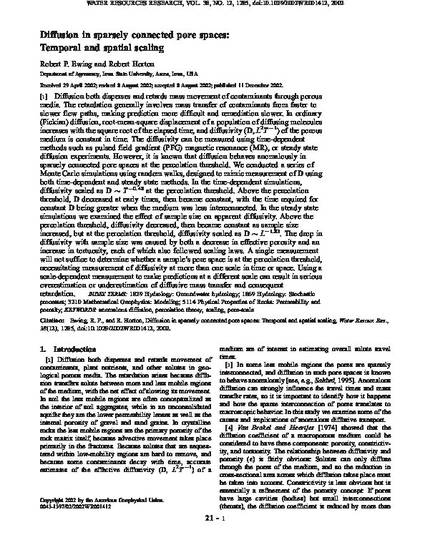
[1] Diffusion both disperses and retards mass movement of contaminants through porous media. The retardation generally involves mass transfer of contaminants from faster to slower flow paths, making prediction more difficult and remediation slower. In ordinary (Fickian) diffusion, root-mean-square displacement of a population of diffusing molecules increases with the square root of the elapsed time, and diffusivity (D, L2T−1) of the porous medium is constant in time. The diffusivity can be measured using time-dependent methods such as pulsed field gradient (PFG) magnetic resonance (MR), or steady state diffusion experiments. However, it is known that diffusion behaves anomalously in sparsely connected pore spaces at the percolation threshold. We conducted a series of Monte Carlo simulations using random walks, designed to mimic measurement of D using both time-dependent and steady state methods. In the time-dependent simulations, diffusivity scaled as D∼ T−0.48 at the percolation threshold. Above the percolation threshold, D decreased at early times, then became constant, with the time required for constant D being greater when the medium was less interconnected. In the steady state simulations we examined the effect of sample size on apparent diffusivity. Above the percolation threshold, diffusivity decreased, then became constant as sample size increased, but at the percolation threshold, diffusivity scaled as D ∼ L−1.83. The drop in diffusivity with sample size was caused by both a decrease in effective porosity and an increase in tortuosity, each of which also followed scaling laws. A single measurement will not suffice to determine whether a sample's pore space is at the percolation threshold, necessitating measurement of diffusivity at more than one scale in time or space. Using a scale-dependent measurement to make predictions at a different scale can result in serious overestimation or underestimation of diffusive mass transfer and consequent retardation.
Available at: http://works.bepress.com/robert-horton/48/

This article is published as Ewing, Robert P., and Robert Horton. "Diffusion in sparsely connected pore spaces: Temporal and spatial scaling." Water resources research 38, no. 12 (2002). doi: 10.1029/2002WR001412. Posted with permission.